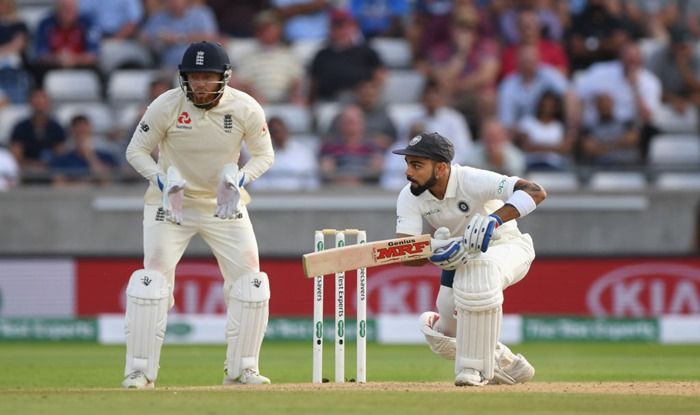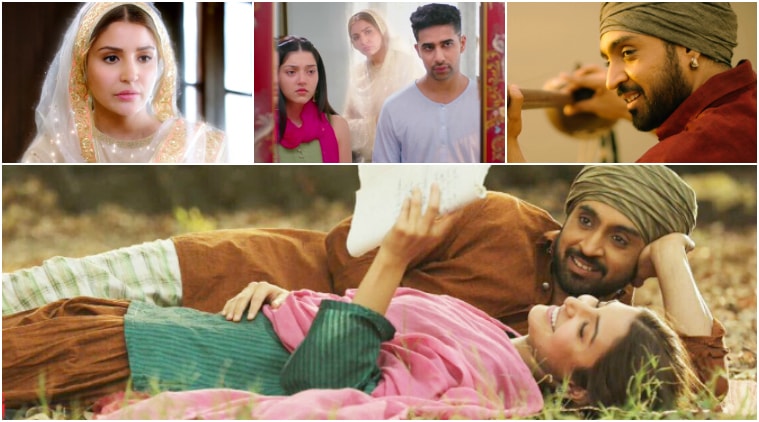Manmarziyan opens with a shot of the Golden Temple, the sort
of thing that in recent times has been one of the lazier clichés in Hindi
cinema: if Sikhs are involved (and sometimes even when they aren’t), Amritsar’s
sacred shrine is a given. However, the vantage
point here is a bit different, enabling the viewer to take in not only the
iconic building, but also an incongruous neon sign perched on top. One is almost tempted to say it doesn’t
belong, except that in India, it sort of does.
That opening shot, if re-visited after the end credits have
rolled, tells you a lot about director Anurag Kashyap’s aims in taking up one
of the most hackneyed Bolly-genres of all – The Love Triangle – and in trying to
give it his own twist. That is, Kashyap
scrupulously adheres to the genre’s conventions in several respects (if I still
need to place a spoiler alert before telling you which hero the lady ends up
with, you haven’t seen very many Hindi films), a marked departure from his
reputation as the industry’s enfant
terrible. This (should I say older,
more mellow?) Kashyap sees much to keep about those conventions, and if the
result is a less radical form and plot than the director has sometimes aspired
to, at least this Hindi film viewer found Manmarziyan a more satisfying film
than a number of Kashyap efforts.
Kashyap doesn’t waste time, establishing locale and
character with great economy in the film’s opening sequences. Taapsee Pannu plays the fiercely independent
Rumi, passionately in love (and lust) with Vicky Sandhu (Vicky Kaushal), who is
“wrong” in all the ways relevant to a family wishing for a suitable “match” for
their daughter, even one as indulgent as Rumi’s (long-suffering) clan seems to
be. Enter Mr. Right, in the form of
Abhishek Bachchan’s Robbie, a London banker in town for an arranged marriage,
and smitten by Rumi, the first woman he sees in Amritsar.
One cannot go much further without talking about the
performances, for these make the film, sustaining it even when the writing
flags. The free-spirited “small town
girl” (recently spotted in Bareilly ki
Barfi, to take one example) has for years been the rather problematic fantasy
of (male!) directors, exotically invested with the sort of agency and
rebelliousness her big city counterparts rarely seem to possess (a sure sign
that the gaze is from the outside in), but Rumi (who is, it must be noted,
written by a woman, Kanika Dhillon), is rescued from staleness by Taapsee Pannu’s
fresh persona. That is to say, the
improbability of Rumi is rendered plausible by Pannu’s newness and conviction,
even if Dhillon’s writing strikes the occasional off-key note (Rumi’s casual
recounting of an abortion was like chalk on a blackboard; I found it hard to
believe that she’d undergo an abortion and be utterly un-marked by the
experience, or so forgiving of the man who couldn’t accompany her because
something had come up). Ultimately, Pannu’s verve and velocity is winning, and
sustains a film she’s in just about every scene of, as indefatigable at the end
as at the beginning. (I wish the filmmakers
had been similarly consistent: early in the film we are told that Rumi has
given up hockey because of a man, but Rumi disagrees: it’s because another
female hockey player has been found dead on the train tracks. The implication, that violent misogyny is to
blame, hangs in the air, discomfiting the viewer. By film’s end, in response to Robbie’s
question, Rumi affirms that she votes, breezily moving on – no discomfort is
risked here, because we are never told who she has voted for; Robbie himself
seems least bothered.)
Vicky Kaushal is even better: entrusted with the un-enviable
task of ensuring the audience doesn’t hate Vicky Sandhu even though he will
have ditched Rumi twice by the intermission, Kaushal plays his difficult role
very well, evoking genuine empathy at key moments. “Difficult” in that Dhillon and Kashyap give
him only one note to hit, and he could easily have lapsed into cartoonish buffoonery.
But as Kaushal plays him, you don’t hate
DJ Vicky for not being ready for marriage, and you can’t help but feel for him
as he tearfully reverses his jeep before it reaches Rumi, who is waiting to
elope with him, and even as your heart goes out to the woman abandoned in the
middle of the night. Indeed, by film’s
end, you can’t help but feel that the newly domesticated Vicky has gotten the
short end of the stick, pushed aside in favor of the film’s adults. But not before Kaushal reminds us yet again why
he is one of Hindi cinema’s most promising actors, adding to the range we’d
seen in Masaan, Raman Raghav 2.0, and Raazi.
Abhishek Bachchan has made an oeuvre out of imbuing with
thoughtfulness, even gravitas, characters who would seem trivial or absurd in
less adept hands (his Rohan Verma, IP lawyer-and-Prince Charming, in Laaga Chunri Mein Daag; and Umraaojan’s Nawab Sultan come to mind). He does so again here, with masterful
restraint and use of pause – silence, in a film so given to talky characters,
anchors the proceedings, and none use it better in contemporary Bollywood than
he does. It is a brave performance, by an actor confident of his restrained craft
in an industry (and public culture) given to celebrating coarseness (especially
coarse masculinity): he is never rushed, and keeps his own time, until, slowly
but surely, Manmarziyan starts to march to his. All the while, he doesn’t appear to be
breaking a sweat, and if Abhishek Bachchan is bothered by the growing marginalization
of what he represents amidst Indian popular culture, it doesn’t show. The one exception in Manmarziyan to this
restraint – when Robbie lashes out at Rumi – is one of the film’s best scenes, even
if neither director nor writer pick up the gauntlet thrown down by Robbie when
he accurately observes that Rumi and Vicky are well-matched, in their
narcissism and the narrowness of the circle they have drawn around themselves. (Nor, one must concede, does Robbie: I
wondered why he continues to be drawn to Rumi.) His isn’t the most important character in
this film, but Bachchan is the film’s most important actor, essential if the
coming-of-age aspect of this film isn’t to be stunted, as so many Hindi film
love stories are, by permanent adolescence.
I don’t know if he entirely succeeds – the film’s rather tame ending is
acutely aware of a movie-going audience that insists on juvenilia – but without
him Manmarziyan would have lost its best shot at an adult love story. Just watch him as he stumbles out onto the
street with the film’s best song, Halla,
playing in the background. One might
think the fate of the world hung in the balance. (The rest of Amit Trivedi’s
album is quite a ways below Halla, and
nowhere near Dev D, but is
reminiscent of the latter in its centrality to the film. Stated differently, Trivedi’s music is the
very texture of Manmarziyan, and so completely that one is hard-pressed to
isolate particular songs beyond a couple of obvious examples.)
No discussion of the film’s performances would be complete without
mention of Saurabh Sachdeva’s turn as a marriage broker – he incarnates a
strange combination of timorousness and watchful callousness, and always
manages to look more intelligent than everyone else in the frame. His back
story points off-screen, and you can’t help but wonder what his story is, what
his life has been like. Many actors can
do justice to their roles, but few add dimension the way Sachdeva does here.
The first half of Manmarziyan
is fantastic, and a feather in Kashyap’s cap: flavorful, tightly edited,
surprising (not least because the director springs Robbie on us earlier than
expected), and visually impressive (the aerial shots of Vicky’s jeep being
driven along a winding road are more reminiscent of the sweep of Gangs of Wasseypur’s opening sequences than
of the standard-issue Punjabi love story), it perhaps should have been the
film. Heck, Kashyap even displays a
hitherto unsuspected talent for staging masala-style songs in the lovable “Dhyaan
kithe Dhyanchand?” video. Kashyap and
Dhillon do so well here that they run out of script at the intermission,
leaving little for the second half but the wait for the inevitable bourgeois
denouement we always see coming (think Hum Dil
De Chuke Sanam). That second half is
more than a few paces off the immensely watchable first: the strong cast (no
one more so than Bachchan), puts in a terrific effort, and meant that my
interest didn’t flag for long, but that doesn’t change my wistfulness for what
might have been had Kashyap and Dhillon continued in the vein of the
pre-intermission portions of the film.
And yet there is plenty here to chew upon in Kashyap’s
staging of the love triangle, in the director’s wanting to have his cake and
eat it too, tapping into the conservative pleasures of the convention while
subverting it from within. The triangle
in Manmarziyan is literally the only one that I am aware of in Hindi film
history that does not leverage parental / societal constraint to create a space
for Hero #2. No forced marriage, no
accident nor pregnancy necessitates marriage to the second-in-time male lead;
here, the lovers themselves principally create the constraints, initially
because of Vicky’s frank inability to commit to Rumi; and subsequently by Rumi’s
impetuosity. Indeed, it is hard to think
of a more sympathetic bunch of cinematic parents and relatives than the ones in
this film. This is bolder than it seems,
and I laud Kashyap and Dhillon for it. For
too long, Hindi cinema has given both, its free-spirited characters (mostly
men), and its conformist audience, a free pass: in films premised on the Love Triangle,
the mess isn’t the fault of the former, and the latter’s sense of order remains
undisturbed because the woman ends up with the more mainstream male character. Manmarziyan
manages a double inversion: here, the mess is very much the fault of the lead
characters, but the audience might not be able to derive great satisfaction
from the otherwise safe ending. By that
point, Rumi’s sexual license, Vicky’s banishment without any patriarchal “assignment”
of his love to his rival, and Robbie’s annulment of the marriage, all mean
there is no social order, no shaadi
to save; even if we presume one will follow off-camera, it isn’t clear everyone
can root for this couple. For this
genre, on this terrain, that will have to be enough.




